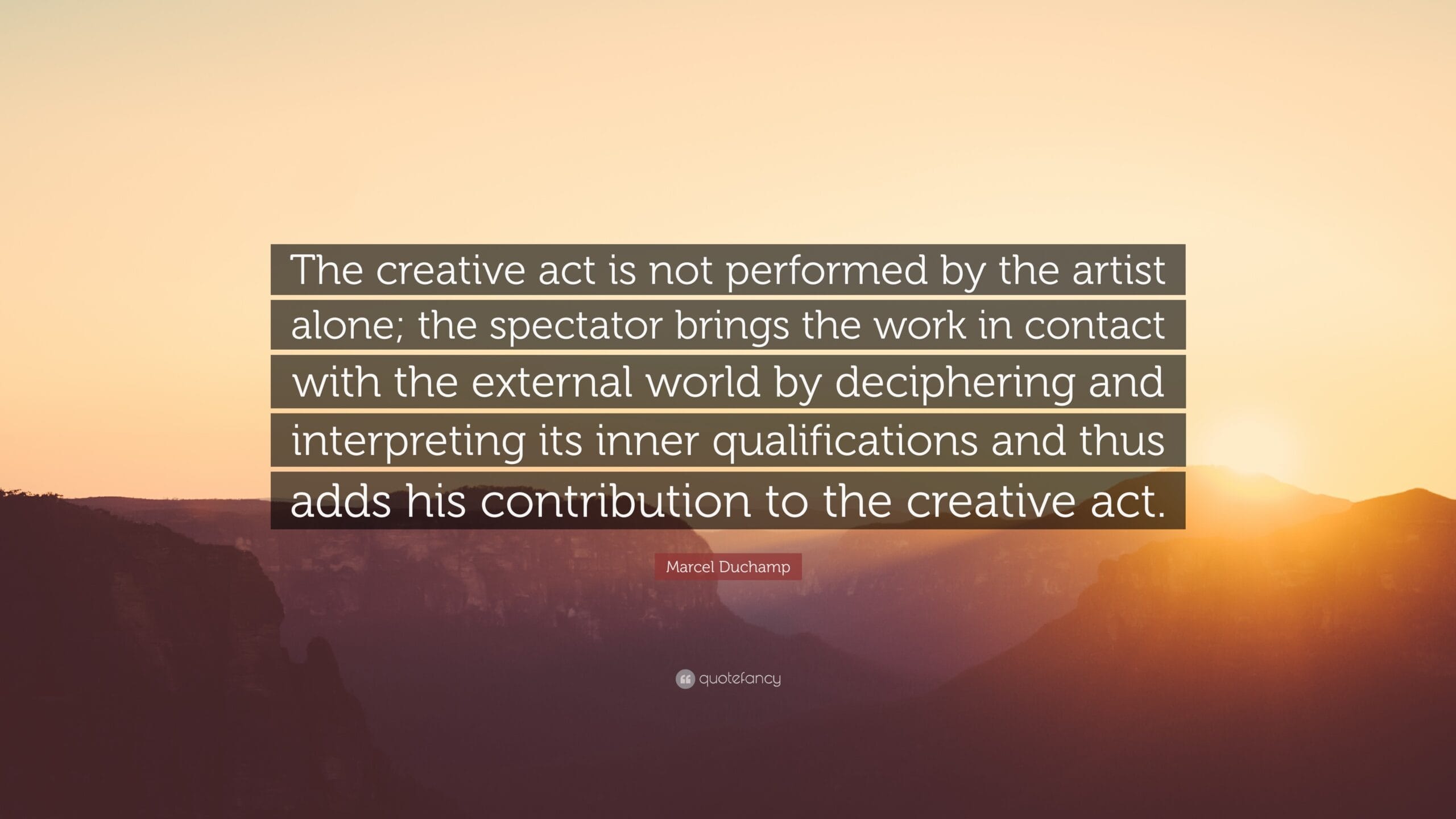Rethinking the Creative Process
What defines art? Artist Marcel Duchamp revolutionized how we answer this question, suggesting the creative process is a collaborative dialogue between artist and spectator. When we view art, we filter it through our personal experiences, reinterpreting and adding to the artist’s initial intent. Duchamp’s groundbreaking theories challenge the traditional notion of artistic ownership, suggesting that meaning-making is a shared experience.
Duchamp’s Revolutionary Idea: The Shared Creative Act
Marcel Duchamp, a pivotal figure in modern art, transformed artistic understanding with his essay “The Creative Act.” He proposed a radical shift, viewing art creation not as a solely artistic endeavor, but as a dynamic interplay between artist and viewer. This perspective significantly impacts how we perceive and interpret art today.
The Artist’s Role: A Spark of Intention
Duchamp viewed the artist’s process as a deeply personal journey, from initial inspiration to realization. This journey involves navigating challenges and embracing unexpected discoveries, shaping the artwork’s potential meaning. The artist doesn’t dictate meaning, but rather sets the stage for an interactive experience.
The Viewer’s Role: Completing the Work
The viewer is an active participant in Duchamp’s model. Their interpretation becomes the key to unlocking the artwork’s meaning. Duchamp referred to this as “transubstantiation,” a transformation of the ordinary into the extraordinary through the viewer’s engagement.
Changing the Art World: A Collaborative Approach
Duchamp’s ideas revolutionized traditional art theory. Elevating the viewer to an equal partner in the creative process challenged the artist’s sole authority. The artwork’s value, in Duchamp’s view, lies in the dynamic exchange between artist and audience.
Duchamp’s Enduring Influence
Duchamp’s 1957 presentation of “The Creative Act” significantly impacted subsequent art movements, particularly Conceptual Art, where the idea becomes paramount.
Exploring Duchamp’s Complexities
Duchamp’s work is filled with nuanced paradoxes, inviting deeper exploration. His self-description as a “mere artist” contrasts with the depth of his philosophical inquiries.
-
Subjectivity and Meaning: Duchamp’s emphasis on subjective experience raises questions about the interplay between artistic intent and individual interpretation. How do personal perspectives shape our understanding?
-
The Art Coefficient: This concept, proposed by Duchamp, represents the “gap” between artistic creation and viewer completion. Some experts believe the art coefficient holds the key to interpreting art, while others emphasize the unique, personal experience.
Duchamp’s “The Creative Act” isn’t a prescriptive formula, but rather an invitation to reconsider art. It encourages us to challenge assumptions and engage more deeply with the creative process, recognizing art’s evolving nature through the continuous interplay between artist and audience.
What Was Marcel Duchamp’s Famous Quote?
“The creative act is not performed by the artist alone; the spectator brings the work in contact with the external world by deciphering and interpreting its inner qualifications and thus adds his contribution to the creative act.”
This quote encapsulates Duchamp’s philosophy. He overturned the traditional artist-centric view, suggesting a collaborative relationship where the viewer completes the artwork. The artwork’s “inner qualifications”—its inherent properties—invite the viewer’s interpretation, becoming a catalyst for meaning-making.
A prime example is Duchamp’s Fountain, a readymade sculpture consisting of a urinal placed on its side. This seemingly mundane object, when presented as art, challenges viewers to decipher its artistic significance. Each viewer brings their unique perspective, transforming the urinal into a statement, a question, or a provocation.
Duchamp’s influence resonates through modern and contemporary art, from Conceptual Art to interactive installations. He transformed viewers from passive observers into active participants. Some experts believe his insights extend beyond art, suggesting that we all interpret reality through our individual lenses, “completing” our experiences of the world.
| Role | Action |
|---|---|
| Artist | Initiates the creative process |
| Viewer | Completes the creative process, adding meaning |
Current scholarship suggests Duchamp may not have fully foreseen the impact of his ideas. New interpretations of his work continue to emerge. While the extent of his influence remains open to debate, he undoubtedly redefined the relationship between art and audience, which continues to be an area of active study.
What Was Duchamp Trying to Say?
Duchamp’s 1957 lecture, “The Creative Act,” significantly challenged conventional art theory, proposing that art is a collaborative endeavor between artist and viewer.
| Artist’s Role | Viewer’s Role |
|---|---|
| Creates, leaves open to interpretation | Interprets, assigns meaning |
The artwork acts as a starting point, a seed planted by the artist, nurtured by the viewer’s interpretive engagement. Meaning is not fixed but fluid, changing according to individual perspectives and experiences. Each interaction creates new layers of significance. Duchamp challenged the artist’s sole authority over meaning, suggesting a dynamic, evolving interpretation.
This perspective fueled artistic movements like Conceptual Art, where the idea takes precedence. Scholars have linked Duchamp’s ideas to later artistic and philosophical developments, though research continues. While debate surrounds aspects of his intentions, he undeniably revolutionized how we understand art, creativity, and the roles of artist and viewer.
Why Did Marcel Duchamp Appropriate the Mona Lisa?
Duchamp’s L.H.O.O.Q.—a postcard of the Mona Lisa adorned with a mustache and goatee—challenges the very notion of art. It’s a readymade, an ordinary object elevated to art status through the artist’s declaration.
Duchamp’s title, “L.H.O.O.Q.,” is a French pun, sounding like “Elle a chaud au cul,” roughly translating to “She has a hot ass.” This playful irreverence adds a layer of provocation, questioning conventional aesthetics and the art establishment’s authority. Scholars have proposed various interpretations, ranging from commentary on art’s commercialization to explorations of gender identity and Dadaist rebellion.
| Feature | Interpretation |
|---|---|
| Readymade | Elevating everyday objects to art |
| Mustache/Goatee | Challenging traditional notions of beauty and femininity |
| Title (L.H.O.O.Q.) | Adding humor, perhaps a sexual undertone |
L.H.O.O.Q. continues to provoke discussion, highlighting art’s interpretive nature. It reminds us that art can be conceptual, challenging conventions. Our potluck sign-up sheet template and Quenya translator offer helpful tools for different kinds of creative endeavors.
Whether Duchamp defaced a masterpiece or created something new remains open to interpretation.
















